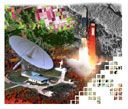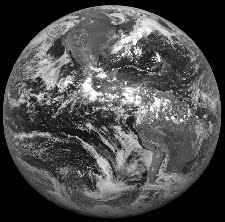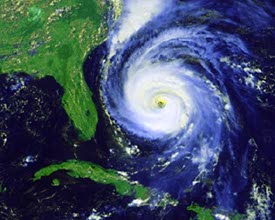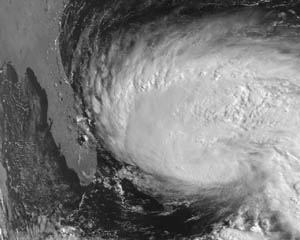
Fundamentals of Remote Sensing
2.11 Weather Satellites/Sensors
 Weather monitoring and forecasting was one of the first civilian (as opposed to military) applications of satellite remote sensing, dating back to the first true weather satellite, TIROS-1 (Television and Infrared Observation Satellite - 1), launched in 1960 by the United States. Several other weather satellites were launched over the next five years, in near-polar orbits, providing repetitive coverage of global weather patterns. In 1966, NASA (the U.S. National Aeronautics and Space Administration) launched the geostationary Applications Technology Satellite (ATS-1) which provided hemispheric images of the Earth's surface and cloud cover every half hour. For the first time, the development and movement of weather systems could be routinely monitored. Today, several countries operate weather, or meteorological satellites to monitor weather conditions around the globe. Generally speaking, these satellites use sensors which have fairly coarse spatial resolution (when compared to systems for observing land) and provide large areal coverage.
Weather monitoring and forecasting was one of the first civilian (as opposed to military) applications of satellite remote sensing, dating back to the first true weather satellite, TIROS-1 (Television and Infrared Observation Satellite - 1), launched in 1960 by the United States. Several other weather satellites were launched over the next five years, in near-polar orbits, providing repetitive coverage of global weather patterns. In 1966, NASA (the U.S. National Aeronautics and Space Administration) launched the geostationary Applications Technology Satellite (ATS-1) which provided hemispheric images of the Earth's surface and cloud cover every half hour. For the first time, the development and movement of weather systems could be routinely monitored. Today, several countries operate weather, or meteorological satellites to monitor weather conditions around the globe. Generally speaking, these satellites use sensors which have fairly coarse spatial resolution (when compared to systems for observing land) and provide large areal coverage.
Their temporal resolutions are generally quite high, providing frequent observations of the Earth's surface, atmospheric moisture, and cloud cover, which allows for near-continuous monitoring of global weather conditions, and hence - forecasting. Here we review a few of the representative satellites/sensors used for meteorological applications.
GOES
 The GOES (Geostationary Operational Environmental Satellite) System is the follow-up to the ATS series. They were designed by NASA for the National Oceanic and Atmospheric Administration (NOAA) to provide the United States National Weather Service with frequent, small-scale imaging of the Earth's surface and cloud cover. The GOES series of satellites have been used extensively by meteorologists for weather monitoring and forecasting for over 20 years. These satellites are part of a global network of meteorological satellites spaced at approximately 70° longitude intervals around the Earth in order to provide near-global coverage. Two GOES satellites, placed in geostationary orbits 36000 km above the equator, each view approximately one-third of the Earth. One is situated at 75°W longitude and monitors North and South America and most of the Atlantic Ocean. The other is situated at 135°W longitude and monitors North America and the Pacific Ocean basin. Together they cover from 20°W to 165°E longitude. This GOES image covers a portion of the southeastern United States, and the adjacent ocean areas where many severe storms originate and develop. This image shows Hurricane Fran approaching the southeastern United States and the Bahamas in September of 1996.
The GOES (Geostationary Operational Environmental Satellite) System is the follow-up to the ATS series. They were designed by NASA for the National Oceanic and Atmospheric Administration (NOAA) to provide the United States National Weather Service with frequent, small-scale imaging of the Earth's surface and cloud cover. The GOES series of satellites have been used extensively by meteorologists for weather monitoring and forecasting for over 20 years. These satellites are part of a global network of meteorological satellites spaced at approximately 70° longitude intervals around the Earth in order to provide near-global coverage. Two GOES satellites, placed in geostationary orbits 36000 km above the equator, each view approximately one-third of the Earth. One is situated at 75°W longitude and monitors North and South America and most of the Atlantic Ocean. The other is situated at 135°W longitude and monitors North America and the Pacific Ocean basin. Together they cover from 20°W to 165°E longitude. This GOES image covers a portion of the southeastern United States, and the adjacent ocean areas where many severe storms originate and develop. This image shows Hurricane Fran approaching the southeastern United States and the Bahamas in September of 1996.
Two generations of GOES satellites have been launched, each measuring emitted and reflected radiation from which atmospheric temperature, winds, moisture, and cloud cover can be derived. The first generation of satellites consisted of GOES-1 (launched 1975) through GOES-7 (launched 1992). Due to their design, these satellites were capable of viewing the Earth only a small percentage of the time (approximately five per cent). The second generation of satellites began with GOES-8 (launched 1994) and has numerous technological improvements over the first series. They provide near-continuous observation of the Earth allowing more frequent imaging (as often as every 15 minutes). This increase in temporal resolution coupled with improvements in the spatial and radiometric resolution of the sensors provides timelier information and improved data quality for forecasting meteorological conditions.
GOES-8 and the other second generation GOES satellites have separate imaging and sounding instruments. The imager has five channels sensing visible and infrared reflected and emitted solar radiation. The infrared capability allows for day and night imaging. Sensor pointing and scan selection capability enable imaging of an entire hemisphere, or small-scale imaging of selected areas. The latter allows meteorologists to monitor specific weather trouble spots to assist in improved short-term forecasting. The imager data are 10-bit radiometric resolution, and can be transmitted directly to local user terminals on the Earth's surface. The accompanying table describes the individual bands, their spatial resolution, and their meteorological applications.
GOES Bands
| Band | Wavelength Range (>mm) | Spatial Resolution | Application |
|---|---|---|---|
| 1 | 0.52 - 0.72 (visible) | 1 km | cloud, pollution, and haze detection; severe storm identification |
| 2 | 3.78 - 4.03 (shortwave IR) |
4 km | identification of fog at night; discriminating water clouds and snow or ice clouds during daytime; detecting fires and volcanoes; night time determination of sea surface temperatures |
| 3 | 6.47 - 7.02 (upper level water vapour) |
4 km | estimating regions of mid-level moisture content and advection; tracking mid-level atmospheric motion |
| 4 | 10.2 - 11.2 (longwave IR) |
4 km | identifying cloud-drift winds, severe storms, and heavy rainfall |
| 5 | 11.5 - 12.5 (IR window sensitive to water vapour) |
4 km | identification of low-level moisture; determination of sea surface temperature; detection of airborne dust and volcanic ash |
The 19 channel sounder measures emitted radiation in 18 thermal infrared bands and reflected radiation in one visible band. These data have a spatial resolution of 8 km and 13-bit radiometric resolution. Sounder data are used for surface and cloud-top temperatures, multi-level moisture profiling in the atmosphere, and ozone distribution analysis.
NOAA AVHRR
NOAA is also responsible for another series of satellites which are useful for meteorological, as well as other, applications. These satellites, in sun-synchronous, near-polar orbits (830-870 km above the Earth), are part of the Advanced TIROS series (originally dating back to 1960) and provide complementary information to the geostationary meteorological satellites (such as GOES). Two satellites, each providing global coverage, work together to ensure that data for any region of the Earth is no more than six hours old. One satellite crosses the equator in the early morning from north-to-south while the other crosses in the afternoon.
The primary sensor on board the NOAA satellites, used for both meteorology and small-scale Earth observation and reconnaissance, is the Advanced Very High Resolution Radiometer (AVHRR). The AVHRR sensor detects radiation in the visible, near and mid infrared, and thermal infrared portions of the electromagnetic spectrum, over a swath width of 3000 km. The accompanying table, outlines the AVHRR bands, their wavelengths and spatial resolution (at swath nadir), and general applications of each.
NOAA AVHRR Bands
| Band | Wavelength Range (mm) | Spatial Resolution | Application |
|---|---|---|---|
| 1 | 0.58 - 0.68 (red) | 1.1 km | cloud, snow, and ice monitoring |
| 2 | 0.725 - 1.1 (near IR) | 1.1 km | water, vegetation, and agriculture surveys |
| 3 | 3.55 -3.93 (mid IR) | 1.1 km | sea surface temperature, volcanoes, and forest fire activity |
| 4 | 10.3 - 11.3 (thermal IR) | 1.1 km | sea surface temperature, soil moisture |
| 5 | 11.5 - 12.5 (thermal IR) | 1.1 km | sea surface temperature, soil moisture |
AVHRR data can be acquired and formatted in four operational modes, differing in resolution and method of transmission. Data can be transmitted directly to the ground and viewed as data are collected, or recorded on board the satellite for later transmission and processing. The accompanying table describes the various data formats and their characteristics.
AVHRR Data Formats
| Format | Spatial Resolution | Transmission and Processing |
|---|---|---|
| APT (Automatic Picture Transmission) | 4 km | low-resolution direct transmission and display |
| HRPT (High Resolution Picture Transmission) | 1.1 km | full-resolution direct transmission and display |
| GAC (Global Area Coverage) | 4 km | low-resolution coverage from recorded data |
| LAC (Local Area Coverage) | 1.1 km | selected full-resolution local area data from recorded data |

Although AVHRR data are widely used for weather system forecasting and analysis, the sensor is also well-suited to observation and monitoring of land features. AVHRR has much coarser spatial resolution than other typical land observations sensors (discussed in the next section), but is used extensively for monitoring regional, small-scale phenomena, including mapping of sea surface temperature, and natural vegetation and crop conditions. Mosaics covering large areas can be created from several AVHRR data sets allowing small scale analysis and mapping of broad vegetation cover. In Canada, AVHRR data received at the Prince Albert Receiving Station Saskatchewan, are used as part of a crop information system, monitoring the health of grain crops in the Prairies throughout the growing season.


Other Weather Satellites
The United States operates the DMSP (Defense Meteorological Satellite Program) series of satellites which are also used for weather monitoring. These are near-polar orbiting satellites whose Operational Linescan System (OLS) sensor provides twice daily coverage with a swath width of 3000 km at a spatial resolution of 2.7 km. It has two fairly broad wavelength bands: a visible and near infrared band (0.4 to 1.1 mm) and a thermal infrared band (10.0 to 13.4 mm). An interesting feature of the sensor is its ability to acquire visible band night time imagery under very low illumination conditions. With this sensor, it is possible to collect striking images of the Earth showing (typically) the night time lights of large urban centres.
There are several other meteorological satellites in orbit, launched and operated by other countries, or groups of countries. These include Japan, with the GMS satellite series, and the consortium of European communities, with the Meteosat satellites. Both are geostationary satellites situated above the equator over Japan and Europe, respectively. Both provide half-hourly imaging of the Earth similar to GOES. GMS has two bands: 0.5 to 0.75 mm (1.25 km resolution), and 10.5 to 12.5 m m (5 km resolution). Meteosat has three bands: visible band (0.4 to 1.1 mm; 2.5 km resolution), mid-IR (5.7 to 7.1 mm; 5 km resolution), and thermal IR (10.5 to 12.5 mm; 5 km resolution).
| Updated2002-08-21 | Important Notices |